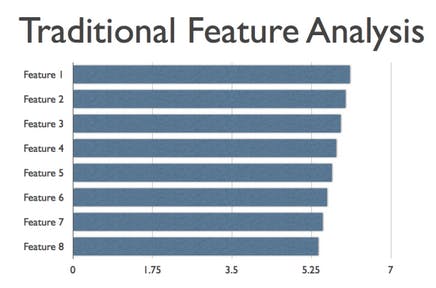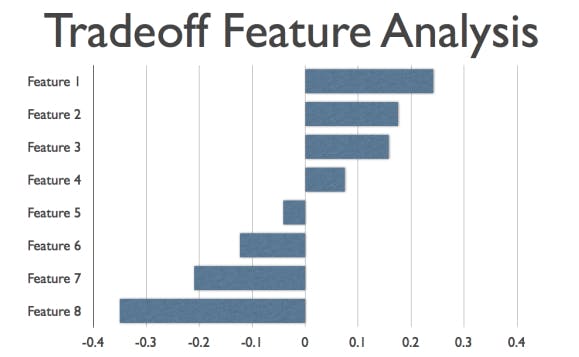I’m a huge fan of Will Ferrell. Go ahead and judge away, but I think he’s hilarious. In a recent Dodge Durango commercial, Ferrell plays his Anchorman character, Ron Burgundy - the leisure suit-wearing news anchor brimming with machismo and a sudden interest in hawking sport utility vehicles. Rather than taking the easy route and listing the Durango’s most popular features, Burgundy is “the only one with the guts” to highlight one of the vehicle’s overlooked features - the glove box.
While the absurdity of showcasing the 2014 Durango’s glove box provides a golden opportunity for humor, boasting about features customers expect (or could care less about) is unfortunately all too common. From a value-based pricing perspective, missing the mark on features can have a devastating effect on your bottom line. So let’s explore the importance of having a handle on feature preferences before learning how you can actually quantify something that has traditionally been thought of as qualitative info. Yay data!
What Is “Feature/Value Preference” And Why Is It Important?
At its core, a “Feature/Value Preference” is simply a determination made by a customer about which feature is most important to her/him. The idea also applies to value propositions (high-level benefits that prompt purchasing decisions) as well. We've dished out a fair amount of criticism regarding JC Penney’s folly of eliminating percentage discounts. Their blunder is a case study in the importance of understanding the value propositions that influence your customers. In the mind of the C-level execs at JCP, the value proposition of “fair and square prices” would trump “25% off” easily. Unfortunately for JCP’s execs (and their 2012 sales projections), the value proposition of “getting a great deal at 25% off” was actually more important to their customers.
If you’re a SaaS company, it’s critical to understand the features that customers are willing to pay for since your pricing page is likely tiered based on a sliding scale running from basic attributes to premium components. Analyzing the features that motivate your customers to buy helps you establish how you package and bundle each pricing tier accordingly. You also don’t have to be a pricing nerd to know that listing out every feature on your pricing page isn’t very practical. For one thing, the “shotgun approach” can intimidate and overwhelm prospective customers in the sales process. Highlighting your most popular features, however, can alleviate this frustration and give you the opportunity to display the very best aspects of your product (for more on pricing page best practices, have a look at our SaaS Pricing Page Pageant).
Additionally, asking customers for their input can do more than just help you identify important features and display them effectively. Current customers often remark that being a part of the process helps them feel included and important. In short, their opinion matters and taking the time to communicate this idea not only helps you create a better pricing page, but also strengthens the tie between you and your customers.
Which Features and Value Propositions Should Take the Spotlight?
There are several ways to measure customer preferences about existing features with some being exponentially more effective than others:
1. Ask Yourself (AKA Guessing)
Bad idea. Gut feelings are important, but staking the success of a new product or service simply on intuition is reckless at best, and plain stupid at worst. We get it, there may not be a lot of market research out there, especially if you’re a first mover in the industry, but there are better ways to gauge consumer sentiments (don’t worry, we’ll be sure to cover a really effective one at the end of this section).
2. Ask the Developer
This makes sense, but be careful. Although it seems logical to rely on the person or team who created the product for their input, the feature preferences of the developer can either be too broad or too narrow. For one thing, they likely spent a lot of time (as well as blood, sweat, and tears) creating the product, so it could be difficult to detach themselves and objectively pick a handful of the most important features. Moreover, features that are paramount to the developer might not be important at all to the end user.
3. Ask the Customer
Getting warmer. The beauty of going “straight to the horses mouth” for feature/value preferences is that it ensures the feedback is at least coming from the correct perspective. Unfortunately, the methods used to collect this data can dramatically influence the results. Asking respondents to “check all the features that are important to you” can generate bias since respondents can easily be swayed by the concept that “more is better.” So, it’s not only about who you ask the question, but how you ask it. The graph below shows what happens when you present customers with the opportunity to have it all.

4. Ask the Customer 2.0 - The Price Intelligently Method
Bingo. Rather than a “rank order” or “check a bunch of boxes” approach, forcing respondents to simply choose a favorite feature and least favorite feature gives you a better opportunity to hone in on the aspects of your offering that are most attractive to customers. Take a look at the next graph below. From here, you can see what customers actually care about because they've been allowed to make tradeoffs.

A Few Final Thoughts
Collecting data surrounding your product’s features and analyzing it thoroughly does take work, but it’s necessary labor if you hope to craft an effective pricing strategy for your business. Before you even think about the numbers you put on your pricing page, taking the time to explore the language that surrounds those numbers guarantees that you are communicating the value of your product in the clearest way possible.
If you want to learn more about the tenets of value-based pricing, take a look at this post on the importance of price sensitivity and how you can measure your customers’ willingness-to-pay with a scientifically-proven methodology.





